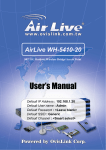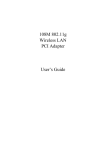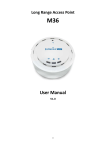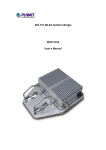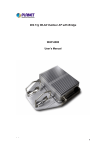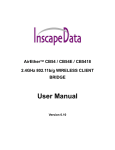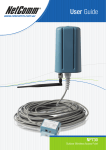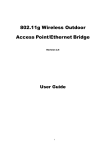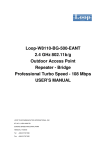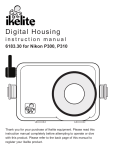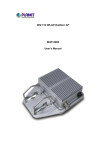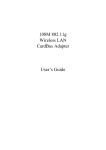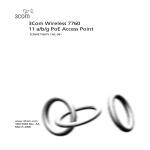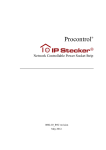Download "user manual"
Transcript
802.11g WLAN Outdoor AP with Bridge WAP-6000 User’s Manual Version 2.0 - 1 Copyright Copyright© 2005 by PLANET Technology Corp. All rights reserved. No part of this publication may be reproduced, transmitted, transcribed, stored in a retrieval system, or translated into any language or computer language, in any form or by any means, electronic, mechanical, magnetic, optical, chemical, manual or otherwise, without the prior written permission of PLANET. PLANET makes no representations or warranties, either expressed or implied, with respect to the contents hereof and specifically disclaims any warranties, merchantability or fitness for any particular purpose. Any software described in this manual is sold or licensed "as is". Should the programs prove defective following their purchase, the buyer (and not this company, its distributor, or its dealer) assumes the entire cost of all necessary servicing, repair, and any incidental or consequential damages resulting from any defect in the software. Further, this company reserves the right to revise this publication and to make changes from time to time in the contents hereof without obligation to notify any person of such revision or changes.. All brand and product names mentioned in this manual are trademarks and/or registered trademarks of their respective holders. FCC Caution: To assure continued compliance.(example-use only shielded interface cables when connecting to computer or peripheral devices). Any changes or modifications not expressly approved by the party responsible for compliance could void the user’s authority to operate the equipment. This device complies with Part 15 of the FCC Rules. Operation is subject to the Following two conditions: (1) This device may not cause harmful interference, and (2 ) this Device must accept any interference received, including interference that may cause undesired operation. Federal Communication Commission (FCC) Radiation Exposure Statement This equipment complies with FCC radiation exposure set forth for an uncontrolled environment. In order to avoid the possibility of exceeding the FCC radio frequency exposure limits, human proximity to the antenna shall not be less than 20 cm(8 inches) during normal operation. Safety This equipment is designed with the utmost care for the safety of those who install and use it. However, special attention must be paid to the dangers of electric shock and static electricity when working with electrical equipment. All guidelines of this and of the computer manufacture must therefore be allowed at all times to ensure the safe use of the equipment. WEEE regulation To avoid the potential effects on the environment and human health as a result of the presence of hazardous substances in electrical and electronic equipment, end users of electrical and electronic equipment should understand the meaning of the - 2 crossed-out wheeled bin symbol. Do not dispose of WEEE as unsorted municipal waste and have to collect such WEEE separately. Revision User’s Manual for PLANET 802.11g WLAN Outdoor AP with Bridge Model: WAP-6000 Rev: 1.0 (December, 2005) Part No. EM-WAP6000v2 - 3 TABLE OF CONTENTS CHAPTER 1 INTRODUCTION.................................................................................................. 1 1.1 PACKAGE CONTENTS ......................................................................................................... 1 1.2 FEATURES ......................................................................................................................... 1 1.3 SPECIFICATION .................................................................................................................. 2 1.5 WIRELESS PERFORMANCE ................................................................................................. 3 CHAPTER 2 HARDWARE INSTALLATION ............................................................................. 4 CHAPTER 3 INITIAL SETUP.................................................................................................... 7 3.1 SETUP PROCEDURES ......................................................................................................... 7 CHAPTER 4 WEB CONFIGURATION...................................................................................... 9 4.1 ACCESS POINT MODE ........................................................................................................ 9 4.1.1 System Summary..................................................................................................... 9 4.1.2 Wireless Station List............................................................................................... 10 4.1.3 System Properties...................................................................................................11 4.1.4 Administration .........................................................................................................11 4.1.5 IP Settings.............................................................................................................. 12 4.1.6 Wireless Network ................................................................................................... 13 4.1.7 Wireless Security ................................................................................................... 13 4.1.8 Wireless Advanced Settings .................................................................................. 17 4.1.9 MAC Filter .............................................................................................................. 19 4.1.10 Backup / Restore Settings ................................................................................... 19 4.1.11 Firmware Upgrade ............................................................................................... 20 4.1.12 Reboot ................................................................................................................. 20 4.2 WIRELESS CLIENT MODE ................................................................................................. 21 4.2.1 Connection Status.................................................................................................. 21 4.2.2 Wireless Network ................................................................................................... 22 4.2.3 Wireless Security ................................................................................................... 23 4.2.4 Ethernet Client List................................................................................................. 24 4.3 REPEATER MODE ............................................................................................................. 24 4.3.1 Wireless Network ................................................................................................... 25 4.3.2 Wireless Security ................................................................................................... 25 4.4 WIRELESS BRIDGE ........................................................................................................... 26 4.4.1 Wireless Network ................................................................................................... 28 4.4.2 Wireless Security ................................................................................................... 28 APPENDIX A GLOSSARY...................................................................................................... 29 - 4 Chapter 1 Introduction Designed with the most innovative 802.11g technology, WAP-6000 provides 54Mbps high data rate for outdoor environment, which is about 30 times faster than T1 and ADSL connection speed. There are four operating modes supported in WAP-6000: AP, AP with WDS (Bridge), Wireless Client, and Repeater. The multiple operation modes selection makes WAP-6000 suitable for widely open space applications such as WISPs, campuses, and airports. In addition to 64/128/152-bit WEP encryption, WAP-6000 integrates WPA, and WPA-PSK to secure the information of your wireless LAN. 1.1 Package Contents Make sure that you have the following items: • • • • • • • • WAP-6000 x 1 Power Adapter x 1 DC injector x 1 Mounting kit x 1 CAT5 cable with RJ-45 plug and ODU connector x 1 N-type to N-type cable x 1 Quick Installation Guide x 1 Utility and User's manual CD x 1 Note: If any of the above items are missing, contact your supplier as soon as possible. 1.2 Features ‧ Wireless LAN IEEE802.11b/g compliant ‧ Solid housing provides protection against rigorous weather conditions ‧ Four operating modes support: AP, AP with WDS (Bridge), Wireless Client, and Repeater ‧ Strong network security with 64/128/152-bit WEP encryption, WPA and WPA-PSK ‧ One detachable reverse N-type male connectors can connect to external antenna for expanding connection distance ‧ 5 levels of adjustable transmit power control ‧ Super G mode raises the data rate up to 108Mbps ‧ Support DHCP Client ‧ Provides “Connection Status” indication for Repeater and Client modes ‧ Power over Ethernet design - 1 1.3 Specification Model WAP-6000 Standard IEEE 802.11b, 802.11g Signal Type DSSS (Direct Sequence Spread Spectrum) Modulation OFDM with BPSK, QPSK, 16QAM, 64QAM, DBPSK, DQPSK, CCK Port 10/100Mbps RJ-45 port * 1 Antenna Connector Reverse N-type male * 1 Output Power 18dBm@11Mbps / 14dBm@54Mbps (typical) 5 levels adjustable (Full, Half, Quarter, Eighth, Minimum) -74dBm@54Mbps OFDM, 10% PER Sensitivity -88dBm@11Mbps CCK, 8% PER Operating Mode AP, AP with WDS (Bridge), Wireless Client, Repeater WEP setting − Authentication type: Open System / Shared Key − Shared keys input type: HEX / ASCII − Shared keys length: (64-bit, 128-bit, 152-bit) − Default WEP Key to use (1-4) WPA-PSK setting Security − PassPhrase − WPA Cipher Type (Auto, TKIP, AES) − Group Key Update Interval: 300 WPA setting − Radius Server IP Address − Radius Port: 1812 − WPA Cipher Type (Auto, TKIP, AES) − Shared Key Group Key Update Interval: 300 Data Rate Super G mode Up to 108Mbps 802.11g Up to 54Mbps (6/9/12/18/24/36/48/54) 802.11b Up to 11Mbps (1/2/5.5/11) Dimensions (L x W x H) 232 x 185 x 62mm Weight 1130g Operating temperature: -20 – 70 degree C Environmental Storage temperature: -30 – 80 degree C Specification Relative humanity: 0% – 90% (non-condensing) - 2 Power Requirement 12V DC, 2.0A Electromagnetic FCC, CE Compatibility 1.5 Wireless Performance The following information will help you utilizing the wireless performance, and operating coverage of WAP-6000. 1. Site selection To avoid interferences, please locate WAP-6000 and wireless clients away from transformers, microwave ovens, heavy-duty motors, refrigerators, fluorescent lights, and other industrial equipments. Keep the number of walls, or ceilings between AP and clients as few as possible; otherwise the signal strength may be seriously reduced. Place WAP-6000 in open space or add additional WAP-6000 as needed to improve the coverage. 2. Environmental factors The wireless network is easily affected by many environmental factors. Every environment is unique with different obstacles, construction materials, weather, etc. It is hard to determine the exact operating range of WAP-6000 in a specific location without testing. 3. Antenna adjustment Please check the specification of the antenna you want to use, and make sure it can be used on WAP-6000. - 3 Chapter 2 Hardware Installation Before you proceed with the installation, it is necessary that you have enough information about the WAP-6000. 1. Locate an optimum location for the WAP-6000. 2. Assemble the antennas to WAP-6000. Try to place them to a position that can best cover your wireless network. The antenna’s position will enhance the receiving sensitivity. 3. Using provided CAT5 waterproof cable; connect the waterproof connector port of the WAP-6000 to the ODU port of DC Injector. 4. Using Category 3 or higher UTP or STP cable, connect the RJ-45 port of DC Injector to a 10Mbps or 10/100Mbps Ethernet hub or switch, and connect the management station to a hub or switch on the same LAN. 5. Connect the output cord of power adapter to the DC Injector’s DC input jack, and plug it into an AC outlet to power up the WAP-6000. 6. Connect the green grounding wire on WAP-6000 to the same grounding system with the AC wall outlet. The grounding system must comply with the National Electrical Code and safety standards that apply in your country. Always check with a qualified electrician if you are in doubt as to whether your outdoor installation is properly grounded. Note: ONLY use the power adapter supplied with the WAP-6000. Otherwise, the product may be damaged. - 4 OUTDOOR INSTALLATION WARNING ! IMPORTANT SAFETY PRECAUTIONS: LIVES MAY BE AT RISK! Carefully observe these instructions and any special instructions that are included with the equipment you are installing. CONTACTING POWER LINES CAN BE LETHAL. Make sure no power lines are anywhere where possible contact can be made. Antennas, masts, towers, guy wires or cables may lean or fall and contact these limes. People may be injured or killed if they are touching or holding any part of equipment when it contacts electric lines. Make sure there is NO possibility that equipment or personnel can come in contact directly or indirectly with power lines. Assume all overhead lines are power lines. The horizontal distance from a tower, mast or antenna to the nearest power line should be at least twice the total length of the mast/antenna combination. This will ensure that the mast will not contact power if it falls either during installation or later. TO AVOID FALLING, USE SAFE PROCEDURES WHEN WORKING AT HEIGHTS ABOVE GROUND. z Select equipment locations that will allow safe, simple equipment installation. z Don’t work alone. A friend or co-worker can save your life if an accident happens. z Use approved non-conducting lasers and other safety equipment. Make sure all equipment is in good repair. z If a tower or mast begins falling, don’t attempt to catch it. Stand back and let it fall. z If anything such as a wire or mast does come in contact with a power line, DON’T TOUCH IT OR ATTEMPT TO MOVE IT. Instead, save your life by calling the power company. z Don’t attempt to erect antennas or towers on windy days. MAKE SURE ALL TOWERS AND MASTS ARE SECURELY GROUNDED, AND ELECTRICAL CABLES CONNECTED TO ANTENNAS HAVE LIGHTNING ARRESTORS. This will help prevent fire damage or human injury in case of lightning, static build-up, or short circuit within equipment connected to the antenna. z The base of the antenna mast or tower must be connected directly to the building protective ground or to one or more approved grounding rods, using 1 OAWG ground wire and corrosion-resistant connectors. - 5 z Refer to the National Electrical Code for grounding details. IF A PERSON COMES IN CONTACT WITH ELECTRICAL POWER, AND CANNOT MOVE: z DON’T TOUCH THAT PERSON, OR YOU MAY BE ELECTROCUTED. z Use a non-conductive dry board, stick or rope to push or drag them so they no longer are in contact with electrical power. Once they are no longer contacting electrical power, administer CPR if you are certified, and make sure that emergency medical aid has been requested. - 6 Chapter 3 Initial Setup The WAP-6000 allows configuration either via the configuration utility, known as PLANET WAP-6000 Locator or Web Browser through network. For the initial installation, we suggest using the PLANET WAP-6000 Locator. Before using Locator, please make sure the personal firewall installed in your PC is disabled. It is strongly recommended to configure and manage WAP-6000 using a wired LAN computer. 3.1 Setup Procedures 1. Insert the bundled CD in the CD-ROM drive to initiate the autorun program. Click on the "PLANET WAP-6000 Locator" hyperlink to activate the program. Or you can start the installation as follows. A. Click on Start Menu/ Run. B. Enter “E:\UTILITY\Locator.exe” in the appeared box, where “E” is the letter of your CD-ROM drive. C. Click on “OK” button. 2. When the Locator is executed, it will search the available WAP-6000 on the same network. The Locator shows you the Device Name, Device Type, IP Address, Ethernet MAC Address and Firmware Version. 3. Assign an IP address to WAP-6000. Just click on the “IP Setting” icon. Then you will see a “Login” dialog box for asking user name and password. Please input your user name and password into the column. Default user name and password are as below: User Name: Admin Password: (blank) Please note the first character of user name is a capital letter. - 7 4. After type in correct user name and password, the utility will lead you into “IP Setting” page. Here you can choose to get IP from a DHCP server or specify IP address manually. Choose to obtain an IP address from DHCP server if your environment or ISP provide DHCP server. Otherwise, you can manually setup IP address. Keep the default IP setting if you are not familiar with TCP/IP setting. After you finish IP setting, click on “Apply” to save the configuration. 5. Please click “Web” icon and refer to next chapter for more configuration of WAP-6000. - 8 Chapter 4 Web Configuration Web configuration provides a user-friendly graphical user interface (web pages) to manage your WAP-6000. An AP with an assigned IP address (e.g. http://192.168.1.1) will allow you to monitor and configure via web browser (e.g., MS Internet Explorer or Netscape). 1. Open your web browser. 2. Enter the IP address of your WAP-6000 in the address field (default IP address is http://192.168.1.1). Please note that your PC’s IP address should be on the same IP subnet of the WAP-6000. For example, you can configure your PC’s IP address to 192.168.1.2 if WAP-6000 is with IP 192.168.1.1. 3. A User Name and Password dialog box will appear. Please enter your User Name and Password here. Default User Name and Password are as below: User Name: Admin Password: (blank) Please note the first character of user name is a capital letter. 4. Then you will see the WAP-6000 web configuration page after click on “OK”. 4.1 Access Point Mode 4.1.1 System Summary System Information • This will display system name and both Ethernet MAC address and Wireless MAC address. Current country setting and firmware version will also be available here. - 9 Current IP Settings • This section shows current IP address setting including IP address, Subnet Mask, Default Gateway and DHCP status. Current Wireless Settings • This area shows current wireless setting including operation mode, wireless mode, SSID, channel and security setting. 4.1.2 Wireless Station List This page can help user identify current clients who already associated to the WAP-6000. You can also click on the MAC address column then the system will show the detail technical information for each wireless station. The page below describes the detail connection information with each station. You can get all information needed right here. - 10 4.1.3 System Properties Device Name You may assign any name to the WAP-6000. Memorable, Unique names are helpful especially if you are employing multiple access points on the same network. The device name needs to be less than 32 characters. After verify the name you input and click “Apply” to save the setting. Country / Region Here you can set the WAP-6000 to follow different country and region regulations. Operation Mode The default operation mode is Access Point; this mode connects your wireless clients to a wired network. In most cases, no change is necessary. You can switch operation mode to Wireless Client, Repeater or Wireless Bridge mode depends on your application. Wireless Client mode can allow AP act as a client within its range. Your Ethernet devices behind the AP client can connect to a remote AP. Repeater is able to retransmit the signal of a remote AP. Choose repeater mode if you want to extend the range of your original AP. Wireless Bridge mode allow you to create a wireless connection to connect the networks between different building. You may check to the section 4.2/4.3 and 4.4 for more details of those operating mode. 4.1.4 Administration - 11 Administrator Name You change the administrator login name in this field. Password Type the new password here if you need to change it. Confirm Password Re-type the new password again, then click the “Apply” below to save the changes. 4.1.5 IP Settings This page can configure system IP address. Default IP address is 192.168.1.1 and Subnet Mask is 255.255.255.0. You can manually input IP address setting or get an IP from a DHCP server. IP Network Setting Here you can choose to get IP from a DHCP server or specify IP address manually. Choose to obtain an IP address from DHCP server if your environment or ISP provide DHCP server. Otherwise, you must manually setup IP address. IP Address If you select “Specify an IP address”, you must enter an unique IP address here. IP Subnet Mask The Subnet Mask must be the same as your Ethernet network setting. Default Gateway Enter the IP address of your gateway here. If your network does not have a Gateway, you can leave this field blank. - 12 4.1.6 Wireless Network SSID The SSID is the unique name shared among all APs and clients in a wireless network. The SSID must be identical for all points in the wireless network. It is case-sensitive and must not exceed 32 alphanumeric characters, which may be any keyboard character. Make sure this setting is the same for all points in your wireless network. For added security, you should change the SSID from the default name default, to a unique name. Suppressed SSID This option can hide the SSID. Enable this function only if you do not want the WAP-6000 to be found by others. Wireless Mode Default setting is “2.4GHz 54Mbps (802.11g)”. This will support all 802.11b/g clients connect to the WAP-6000. You can choose “2.4GHz 11Mbps (802.11b)” in wireless mode column if your environment has only 802.11b clients. The final selection “2.4GHz 108Mbps (802.11 SuperG)” supports high-speed 108Mbps SuperG function. In order to support SuperG 108M transmission, all wireless clients will need to be Atheros® solution. Channel / Frequency Select the appropriate channel from the list provided to correspond with your network settings. All points in your wireless network must use the same channel in order to function correctly. The default setting is “SmartSelect” means the system will pick best channel for you automatically. Stay with default setting if you do not have special request on channel selection. 4.1.7 Wireless Security The wireless security settings configure the security of your wireless network. There are three wireless security mode options supported by the WAP-6000: WEP, WPA-PSK and WPA. (WPA stands for Wi-Fi Protected Access, which is a security standard stronger than WEP encryption. WEP stands for Wired Equivalent Privacy.) In Wireless Security page, you can configure the AP to work with No Security, WEP, WPA-PSK and - 13 WPA security mode. Once you setup the AP to work in security mode, all wireless stations will also need to have corresponding settings. System default setting is “No Security”. WEP Authentication type Select the appropriate value - "Open System" or "Shared Key". All Wireless stations must then be set to use the same method. - 14 Shared keys input Select HEX or ASCII depends on your preference. type Default key The default key, selected by the radio button, is required. The other keys are optional. Other stations must have matching key values. Shared key There are 4 keys available, please ensure you have enter correct number for the key values with different Key Length and coding (Hex or ASCII). Key length Select the level of encryption you want among the options. WAP-6000 supports 64, 128, and 152-bit encryptions. After all changes are made, be sure to click on “Apply” to make sure all changes are saved into system. WPA-PSK Passphrase Enter a hard-to-guess passphrase (between 8 and 63 characters) in the field. Cipher type WPA gives you two encryption methods, TKIP and AES, with dynamic encryption keys. Select the type of algorithm, TKIP or AES. Group key update Enter the time interval in seconds which instructs the WAP-6000 how often it interval should change the encryption keys. Usually the security level will be higher if you set the period shorter to change encryption keys more often. Default value is 1800 seconds. Setting 0 in this field would disable key renewal. After all changes are made, be sure to click on “Apply” to make sure all changes are saved into system. - 15 WPA RADIUS server Enter the IP address of your RADIUS server. RADIUS port Specify the port number for RADIUS service, default value is 1812. RADIUS secret RADIUS secret is the key shared between WAP-6000 and RADIUS server. Cipher type WPA gives you two encryption methods, TKIP and AES, with dynamic encryption keys. Select the type of algorithm, TKIP or AES. Group key update Enter the time interval in seconds which instructs the WAP-6000 how often it interval should change the encryption keys. Usually the security level will be higher if you set the period shorter to change encryption keys more often. Default value is 1800 seconds. Setting 0 in this field would disable key renewal. After all changes are made, be sure to click on “Apply” to make sure all changes are saved into system. - 16 4.1.8 Wireless Advanced Settings Data rate You can select all data rates supported in current operation mode. Default value is “best” which means the system will automatically adjust the connection speed dynamically according to your current link status. Transmit power You can reduce RF output power by selecting Half (-3dB) / Quarter (-6dB) / Eighth (-9dB) / Minimum. To change transmit power may decrease your wireless signal coverage. Beacon interval This value indicates the frequency interval of the beacon. A beacon is a (20-1000) packet broadcast by the WAP-6000 to keep the network synchronized. A beacon includes the wireless LAN service area, the AP address, the Broadcast destination address, a time stamp, Delivery Traffic Indicator Maps, and the Traffic Indicator Message (TIM). Data beacon rate Enter a value between 1 and 255 that specifies the Delivery Traffic Indication (DTIM) (1-255) Message (DTIM). A DTIM is a countdown informing clients of the next window for listening to broadcast and multicast messages. When the AP has buffered broadcast or multicast messages for associated clients, it sends the next DTIM with a DTIM Interval value. AP Clients hear the beacons and awaken to receive the broadcast and multicast messages. - 17 Fragment length This specifies the maximum size of a data packet. It should remain at its (256-2346) default setting of 2,346. A smaller setting means smaller packets, which will create more packets for each transmission. If you have decreased this value and experience high packet error rates, you can increase it again, but it will likely decrease overall network performance. Only minor modifications of this value are recommended. RTS/CTS threshold Enter the preferred setting between 256 and 2346. Normally, this can be left (256-2346) at the default value. Short preamble Preambles are a sequence of binary bits that help the receivers synchronize and ready for receipt of a data transmission. Some older wireless systems like 802.11b implementation use shorter preambles. If you are having difficulty connecting to an older 802.11b device, try to enable short preamble. Protection mode Protection Mode should remain default value (Auto) unless you are having severe problems with your 11g Wireless LAN products not being able to transmit to the WAP-6000 in an environment with heavy 802.11b traffic. To enable this function boosts the WAP-6000’s ability to catch all 11g Wireless transmissions but will severely decrease performance. Extended Range Atheros eXtended Range technology is fully compatible with IEEE and Wi-Fi Alliance standards. In outdoor environments, XR enables more economical point to point fixed wireless system and provides for greater utility of public hot spots infrastructure with increased numbers of users able to connect each access point. Distance (1-30) Setup “Distance” according to the longest link distance between the point to point or point to multi-point in the network. The input needs to be greater than or equal to the real distance. The range can be from 1KM to 30KM for normal mode and 1KM to 15 KM in Super mode. After all changes are made, be sure to click on “Apply” to make sure all changes are saved into system. - 18 4.1.9 MAC Filter Click on the “Enable MAC Filtering” button, the rule have allow only station in list (accept) or allow any station unless in list (deny). You can edit the MAC Filtering Table in you need associated the access point. 4.1.10 Backup / Restore Settings Backup the current Click on the “Backup” button, system will prompt you where to save the settings to a file backup file. You can choose the directory to save your configuration file. Restore settings You can restore the configuration file from where you previously saved. from a backup file Restore factory Please be careful before restore system back to default since you will lose all default settings current settings immediately. - 19 4.1.11 Firmware Upgrade Enter the location of the new firmware file in the file path field, or click the “Browse” button to find the firmware upgrade file. Then click on the “Upgrade” button, and follow the on-screen instructions. The whole firmware upgrade process will take around 60 seconds. 4.1.12 Reboot Click on “Reboot” button to restart WAP-6000. - 20 4.2 Wireless Client Mode WAP-6000 can also work as an Ethernet client bridge to connect up to 16 Ethernet device into wireless network. In order to setup the WAP-6000 to work in Ethernet bridge mode, you need to choose “Wireless Client” mode and click “Apply” at System Properties page. You also need to reboot the WAP-6000. After the system reboot is done, you can see the page as below. Status page shows the WAP-6000 is now working in Wireless Client mode. 4.2.1 Connection Status - 21 Network type Here indicates the WAP-6000 works in AP mode or Client mode (Infrastructure mode / Ad Hoc mode). SSID Here displays current SSID assigned to the WAP-6000. BSSID The MAC address of the associated AP. Connection status This column shows current connection status. If WAP-6000 already connects to an Access Point or station, here will show “Associated”. Otherwise, connection column will show “N/A” which means no connection to any Access Point or station. Wireless mode Here show the Access Point current work in 11b, 11g, or super G mode. Current channel This column indicates the radio channel currently in use. Security Here indicates AP security settings in client mode. Should be either “Disabled”, “WEP” or ‘WPA-PSK”. Rx data rate (Mbps) Displays current receive data rate. Tx data rate (Mbps) Displays current transmit data rate. Link quality This column shows current link quality with AP in 0 to 100 percentage scale. Signal strength This column shows current signal strength with AP in 0 to 100 percentage scale. Activity Displays the number of packets received and transmitted through this WAP-6000. 4.2.2 Wireless Network - 22 Network mode You can set the wireless client into 2 different modes by clicking radio button. Wireless Client (Infrastructure) act as an AP client while Ad-hoc can support peer-to-peer network. The Infrastructure mode can support up to 108M SuperG transmission. Wireless mode Select the proper mode according to your wireless network. SSID The SSID is the unique name shared among all points in a wireless network. The SSID must be identical for all points in the wireless network. It is case-sensitive and must not exceed 32 alphanumeric characters, which may be any keyboard character. You can choose “Attach to any available SSID”; system will determine the Access Point currently available and establish connection with that Access Point. If you already understand your wireless environment well, you can type in the SSID in “Specify the static SSID” manually. Moreover, you can easily click on the “Site Survey” to find all wireless networks available in your current environment. Please refer to the description below. Site Survey The Site Survey page can help you identify all available APs in your environment. Just easily click on the BSSID column; the system will join you to the SSID you specify after reboot. In the Site Survey page you can also see the details of all SSID currently available. 4.2.3 Wireless Security In Wireless client mode, WAP-6000 has support WEP and WPA-PSK security mechanisms. Please refer to section 4.1.7 for detailed descriptions of the security configuration. - 23 4.2.4 Ethernet Client List You can check all the details about Ethernet clients including IP Address and MAC Address. Press “Refresh” if you add any new Ethernet client into network. The page will update latest status of current Ethernet network. 4.3 Repeater Mode Repeater is able to retransmit the signal of a remote AP. Choose repeater mode if you want to extend the range of your original AP. In order to setup this mode, you need to choose “Repeater” mode and click “Apply” at System Properties page. You also need to reboot the WAP-6000 to make the setting effective. - 24 4.3.1 Wireless Network After enable the repeater mode, you can click on “Wireless Network” and choose “Site Survey” to pick one of the SSIDs you would like to retransmit its signal. (Please be noted that while using the repeater mode, the throughput performance maybe nearly only half compare with Access Point mode. Because the repeater needs to communicate with original AP and also the clients associate to the repeater at the same time.) Site Survey After click on the “Site Survey” button, you can choose the Access Point you need to extend its range by clicking on “BSSID” column. Then “Apply” the change to make sure system working properly with new setting. After all the changes are made, you can check the “Connect Status” page to check current SSID and link quality / signal strength. Some more information is available at that page. 4.3.2 Wireless Security In Repeater mode, WAP-6000 supports only WEP security mechanisms. Please refer to section 4.1.7 for detailed descriptions. - 25 4.4 Wireless Bridge Wireless Bridge is WDS (Wireless Distribution System) operation as defined by the IEEE802.11 standard has been made available. In IEEE 802.11 terminology a "Distribution System" is system that Interconnects, so-called, Basic Service Sets (BSS). A BSS is best compared to a "Cell", driven by a single Access Point (one of those circles in the diagram below). So a "Distribution System" connects cells in order to build a premise wide network which allows users of mobile equipment to roam and stay connected to the available network resources. Wireless Bridge (WDS) is used for wirelessly connect Access Points, and in doing so extend a wired infrastructure to locations where cabling is not possible or inefficient to implement. (Be sure you understand the purpose of WDS mode before proceed configuration.) The Wireless Bridge (WDS) mode is coexisting with Wireless Bridge (WDS) mode in this AP, therefore, you can support regular wireless stations or WDS link. In the “WDS Link Settings”, check box and switch the “Mode” to “Enable”. Then you are able to fill in MAC Address of each WDS link Settings. - 26 Considerations before installation – z Loop Prevention – Be careful to plan you WDS connections, prevent your wireless network topology to have loop. Once loop shows up, you network traffic will become unstable. z Performance – The system can support up to 8 WDS links. But all links and wireless stations that operate at the same time will all share single radio bandwidth. (Ex. 11g have 54Mbps bandwidth) z Latency – In the chain topology configuration, if the chain becomes very long, end-to-end latency issue may come in play. We suggest the WDS link topology planning should not exceed 2 hops in chain configuration. - 27 4.4.1 Wireless Network After enable the Wireless Bridge mode, you can click on “Wireless Network” to assign the SSID, Wireless Mode and Work Channel. 4.4.2 Wireless Security WDS mode has support WEP and WPA-PSK. Please refer to section 4.1.7 for the detail of the configuration. - 28 Appendix A Glossary 802.11b - An IEEE wireless networking standard that specifies a maximum data transfer rate of 11Mbps and an operating frequency of 2.4GHz. 802.11g - An IEEE wireless networking standard that specifies a maximum data transfer rate of 54Mbps, an operating frequency of 2.4GHz, and backward compatibility with 802.11b devices. Adapter - This is a device that adds network functionality to your PC. Ad-hoc - A group of wireless devices communicating directly with each other (peer-to-peer) without the use of an access point. Backbone - The part of a network that connects most of the systems and networks together, and handles the most data. Bandwidth - The transmission capacity of a given device or network. Beacon Interval - Data transmitted on your wireless network that keeps the network synchronized. Bit - A binary digit. Browser - An application program that provides a way to look at and interact with all the information on the World Wide Web. CSMA/CA (Carrier Sense Multiple Access/Collision Avoidance) - A method of data transfer that is used to prevent data collisions. CTS (Clear To Send) - A signal sent by a wireless device, signifying that it is ready to receive data. Database - A collection of data that is organized so that its contents can easily be accessed, managed, and updated. DHCP (Dynamic Host Configuration Protocol) - A networking protocol that allows administrators to assign temporary IP addresses to network computers by "leasing" an IP address to a user for a limited amount of time, instead of assigning permanent IP addresses. Download - To receive a file transmitted over a network. DSSS (Direct-Sequence Spread-Spectrum) - Frequency transmission with a redundant bit pattern resulting in a lower probability of information being lost in transit. DTIM (Delivery Traffic Indication Message) - A message included in data packets that can increase wireless efficiency. Encryption - Encoding data transmitted in a network. Ethernet - IEEE standard network protocol that specifies how data is placed on and retrieved from a common transmission medium. Firmware - The programming code that runs a networking device. - 29 Fragmentation -Breaking a packet into smaller units when transmitting over a network medium that cannot support the original size of the packet. Gateway - A device that interconnects networks with different, incompatible communications protocols. Hardware - The physical aspect of computers, telecommunications, and other information technology devices. IEEE (The Institute of Electrical and Electronics Engineers) - An independent institute that develops networking standards. Infrastructure - A wireless network that is bridged to a wired network via an access point. IP (Internet Protocol) - A protocol used to send data over a network. IP Address - The address used to identify a computer or device on a network. ISM band - Radio bandwidth utilized in wireless transmissions. ISP (Internet Service Provider) - A company that provides access to the Internet. LAN - The computers and networking products that make up your local network. MAC (Media Access Control) Address - The unique address that a manufacturer assigns to each networking device. Network - A series of computers or devices connected for the purpose of data sharing, storage, and/or transmission between users. Node - A network junction or connection point, typically a computer or work station. Packet - A unit of data sent over a network. Passphrase - Used much like a password, a passphrase simplifies the WEP encryption process by automatically generating the WEP encryption keys for Linksys products. Port - The connection point on a computer or networking device used for plugging in cables or adapters. Roaming - The ability to take a wireless device from one access point's range to another without losing the connection. Router - A networking device that connects multiple networks together. RTS (Request To Send) - A networking method of coordinating large packets through the RTS Threshold setting. Server - Any computer whose function in a network is to provide user access to files, printing, communications, and other services. SNMP (Simple Network Management Protocol) - A widely used network monitoring and control protocol. Software - Instructions for the computer. A series of instructions that performs a particular task is called a "program". SOHO (Small Office/Home Office) - Market segment of professionals who work at home or in small offices. Spread Spectrum - Wideband radio frequency technique used for more reliable and secure - 30 data transmission. SSID (Service Set IDentifier) - Your wireless network's name. Static IP Address - A fixed address assigned to a computer or device that is connected to a network. Subnet Mask - An address code that determines the size of the network. Switch - 1. A data switch that connects computing devices to host computers, allowing a large number of devices to share a limited number of ports. 2. A device for making, breaking, or changing the connections in an electrical circuit. TCP (Transmission Control Protocol) - A network protocol for transmitting data that requires acknowledgement from the recipient of data sent. TCP/IP (Transmission Control Protocol/Internet Protocol) - A set of instructions PCs use to communicate over a network. TKIP (Temporal Key Integrity Protocol) - a wireless encryption protocol that provides dynamic encryption keys for each packet transmitted. Topology - The physical layout of a network. Upgrade - To replace existing software or firmware with a newer version. WEP (Wired Equivalent Privacy) - An optional cryptographic confidentiality algorithm specified by IEEE 802.11 that may be used to provide data confidentiality that is subjectively equivalent to the confidentiality of a wired local area network (LAN) medium that does not employ cryptographic techniques to enhance privacy confidentiality. WPA (Wi-Fi Protected Access) - a wireless security protocol using TKIP (Temporal Key Integrity Protocol) encryption, which can be used in conjunction with a RADIUS server. - 31



































